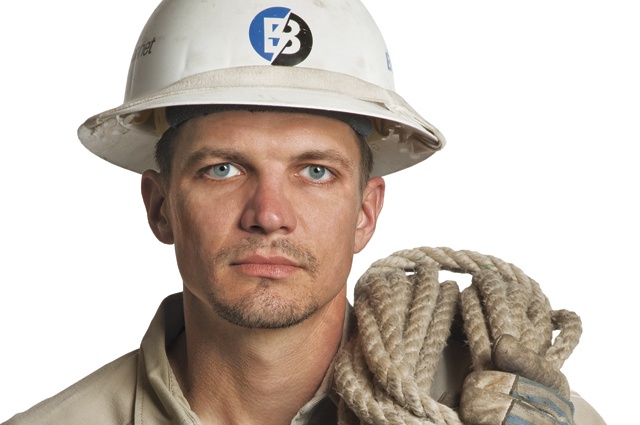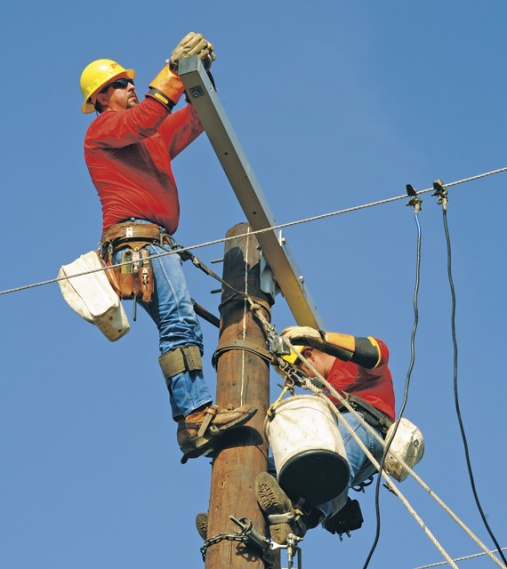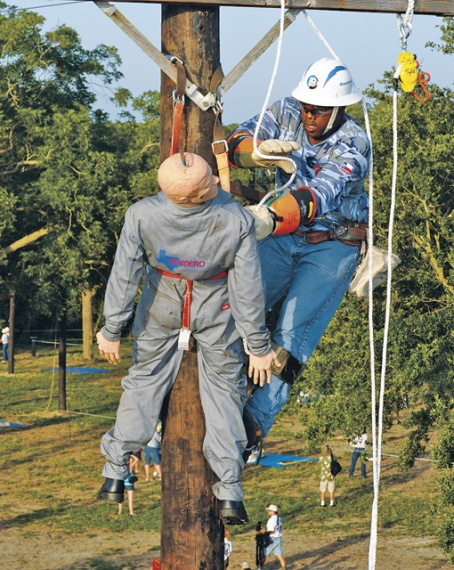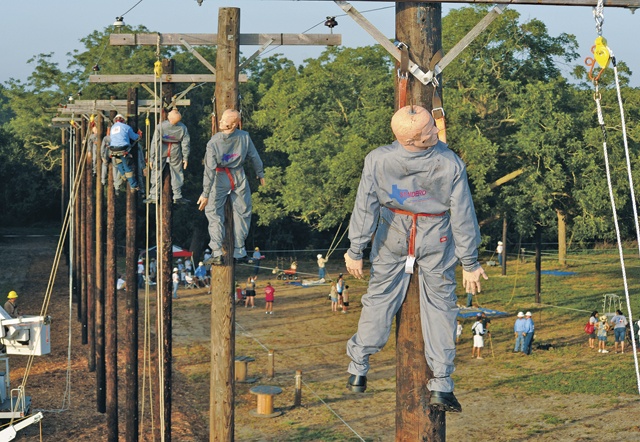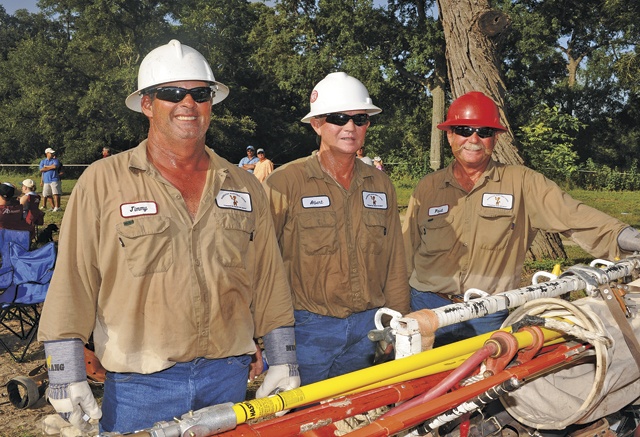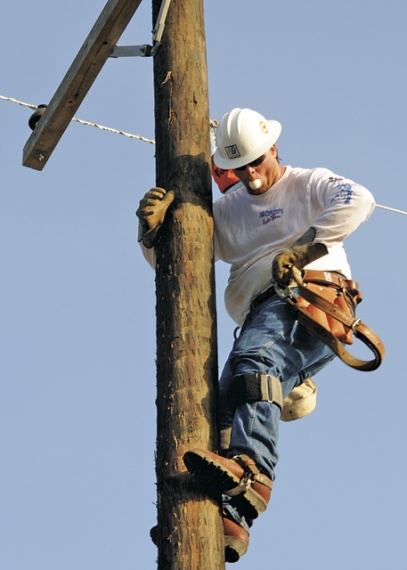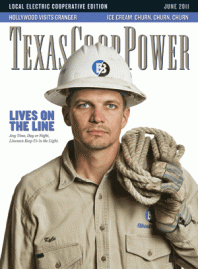The wind is howlin’ … The snow is blowin’
He’s somebody’s hero without them knowin’
Just who he is or what he did tonight
When you throw a switch and the lights come on
Remember the one who left his home
To hold the lines and keep us shining bright
He’s a lineman … Yeah he’s a lineman
Chorus from “Somebody’s Hero,” co-written by Chick Herrin, aka “The Singing Lineman”
—————–
Six a.m. Equipment trailer lights prick the darkness. Shadowy figures move robotically, methodically, speaking in hushed, somber tones. The early morning air lies still, seemingly safety-pinned into place like the competition numbers on the electric linemen’s backs.
It’s deceptively cool 45 minutes before sunrise. No hint yet of the broiling July heat soon to punish the field in the 2010 Texas Lineman’s Rodeo southeast of Seguin.
Poker-faced apprentices keep their hands busy, their minds clamping on the 50-question, written exam that starts their competition at 7 a.m. Focus. Stay as sharp as the test-taking pencils they’re about to grip. Help journeyman linemen transfer gear from trailers to carts. Climbing belts. Hooks. Safety straps. Hand lines. Hot sticks.
Some competitors sit alone. HILCO Electric Cooperative First-Class Lineman Kane Montgomery rhythmically threads yellow laces through the hooks and eyelets on his 16-inch-tall leather lineman boots. It’s a five-minute job. Montgomery’s grim face, set like concrete, yields no clues as to his feelings about the day’s grueling lineup of events.
“A little nervous,” he finally says, allowing a soft smile. “Not too bad once you get going.”
One by one, team by team, the men representing electric co-ops and investor-owned and municipal utilities emerge from their trailers. As the first rays of light penetrate Nolte Island Park, heads bow for the invocation. Hard hats and hands rest over hearts for the playing of the national anthem.
A bucket truck lifts Chick Herrin, the only living member of the inaugural class inducted into the International Lineman’s Hall of Fame, into position at the facility’s entrance. Tucked between U.S. and Texas flags secured atop utility poles, Herrin, a retired Bryan Texas Utilities manager and lineman, oversees the opening ceremony from his lofty perch.
Then comes the booming cry from Bobby Christmas, chairman of the board of directors for the Texas Lineman’s Rodeo Association: “ARE YOU READY TO RODEO?”
The linemen whoop their affirmative response. Let the competition begin.
‘Excuse Me for a Second—Gotta Work’
Seven a.m. The climbing sun glowers like an angry, red-orange face. Life-size mannequins wearing gray coveralls hang from poles, their bald heads eerily turned sideways as though trying to look down to see who’s coming up to save them. This is Hurtman Rescue, one of the rodeo’s most popular events.
Jeff Hohlt is up first for his team, Bluebonnet Electric Cooperative. Right hand, right foot, left hand, left foot, the steel gaffs strapped to his boots digging into the wood, the 51-year-old crew supervisor climbs with the precise motion of a piston. The rescue expertly performed, Hohlt comes off the pole, breathing hard with sweat dripping off his nose and into his brown-gray moustache.
Now it’s teammate Kenny Roland’s turn. “Going up the wood!” he shouts, zipping up the pole.
“You got it, Kenny!” Hohlt hollers. “Get that man down!”
Hohlt cranes his neck as he patiently answers a reporter’s questions about the event. “Excuse me for a second,” he says apologetically, never taking his eyes off Roland. “Gotta work.”
Hard Work. Dangerous Work.
Hard hats and hard work. Hardheaded guys who let nothing—sandstorms, hailstorms, tornados, swarming mosquitoes, lack of sleep—stop them from restoring power for those they serve. Yes, ma’am. Yes, sir. Power’s out? No worries. We’re on our way.
“When the lights go out,” Hohlt says, “we have to go to work.”
That means bundling up for work in the freezing cold, when transmission and distribution lines have snapped under the weight of ice. It means changing fuses when the wind’s gusting 40 mph or more. It means crawling over mangled trees and chain sawing a path for the repair of broken poles and tangled, downed wires in the wake of thunderstorms and hurricanes.
It means, as one story from East Texas-based Sam Houston Electric Cooperative goes, crossing a creek by boat at night, accidentally dropping your hand light overboard and resignedly watching it shine out of sight into the alligator-inhabited depths. More power to ’em.
It means facing the constant risk of falls, electrical burns, electrocution and other life-threatening accidents and injuries in what is one of the most dangerous occupations in the U.S.
Despite the conditions or inherent risks of the job, electric linemen are always ready to pull their boots on, says Christmas, engineering and operations division manager for Guadalupe Valley Electric Cooperative. “They are the epitome of what makes Texas and America great,” he says.
Linemen still climb poles when bucket trucks can’t access alleys or storm-ravaged areas. They routinely work with high voltage and, most significantly, electrical current that can kill a human with a flow of less than 1 ampere.
“I have seen what it does to a bird, or a squirrel or a snake,” Christmas says. “I wouldn’t want to see what it could do to me.”
‘Headache!’
Seven thirty-five a.m. Bluebonnet EC’s Kenny Roland reaches the mannequin and buckles off, looping his safety strap around the pole and rehooking it to his climbing belt. Now secured to the pole, his spur-like climbing gaffs sunk into the wood, Roland leans back with the belt supporting his full weight.
With gloved hands, he wraps a hand line under the mannequin’s arms and ties three half-hitch knots, cinching the rope snug against the mannequin’s chest. Roland’s almost done: He hollers “Headache!” in a traditional lineman warning to those standing below and drops the rope’s pulley block—standard lineman gear used to raise and lower equipment—to the ground. Then he cuts the mannequin’s leather safety strap. The “hurt man” swings free, and Roland controls its every move to the mulch beneath the pole, doling out rope like a puppet master.
The strain shows on Roland’s face: The mannequins, their chests filled with 20-pound bags of birdshot, typically weigh well over 150 pounds. But judges don’t cut the competitors any slack: It’s a two-point gig, or demerit, if the mannequin hits the pole after its initial swing. It’s a 10-point gig—the so-called kiss of death for trophy dreams—if the lineman lets the mannequin free-fall to the ground. No safety nets here.
Even though the “hurt men” are made of pliable rubber and the overhead lines are dead, competitors treat the Texas Lineman’s Rodeo as a live performance: It’s a chance to show off for friends and family members and impress the judges who determine the trophy winners strutting across the stage at day’s end.
But beneath the friendly ribbing, a deadly seriousness takes hold. There’s no clowning around, even in Pole Climb, a speed event requiring balance and control in which competitors descend with a raw egg in their mouths. Crack or break the shell, and the yolk’s on you—along with a very unfunny 10-point gig.
Safety First, Then Perfection
The rodeo preaches safety first, then perfection as judges score teams, climbers and groundmen on how well they work together. From tying knots that won’t come loose under pressure to the generational ties that bind, good communication is of the essence: Older linemen, such as Bluebonnet EC’s Hohlt, competing last year in the 45-and-older seniors division, show youngsters the ropes—and prove that they’re still pretty dadgum fast at climbing poles.
Rodeo officials, in turn, introduce events every year that challenge all competitors to learn skills that make them safer and better linemen—and, ultimately, increase their value on the job market and to their employers.
As the utility industry takes on more sophisticated and high-tech dimensions, so grows the demand for well-trained electric linemen. Based on several factors, including the building of wind-power transmission lines in the Panhandle, the Texas Workforce Commission projects that the number of power lineworker jobs will have increased roughly 20 percent between 2006 and 2016.
Coupled with an approaching lineman shortage—many of the state’s electric co-ops project that 10 percent to more than 40 percent of their line workers will be eligible for retirement in the next five to 10 years—there’s a sense of urgency: Now, more than ever, Texas needs electric linemen who can do it all.
Texas Electric Cooperatives (TEC), the statewide association that represents the interests of 76 electric co-ops, advises 10 Texas colleges on what to include in electric lineman training curriculum. TEC has been working hard for several years to fill the projected retirement gaps, says Tiffin Wortham, vice president, TEC Member Services.
“The lineman’s career is very rewarding, and just a couple of semesters’ work at a local college can start the right individual in a career that will last a lifetime,” he says.
‘Power to the People’
Like a welding torch drawing a bead, the sun zeroes in on linemen, some of whom chill down inside a zipped-tight, air-conditioned tent. Water jugs and ice-packed coolers of bottled water line the rodeo grounds. Competitors guzzle fluids, as much as their bellies will hold.
Live oak and pecan trees spread their branches over much of the rodeo grounds, including a simultaneously occurring rodeo barbecue competition. But the linemen, isolated atop poles on a cloudless day, simply bake in the near 100-degree heat, with shade and the Guadalupe River circling the park a tempting glance away.
Hamilton County Electric Cooperative Line Superintendent Albert Pafford, his button-down, long-sleeved shirt darkened from tan to a sopping brown, comes off the pole in the 600 Amp Switch Change event so wet with sweat it looks like he’s been thrown in the river. The lithe and sinewy 54-year-old is competing in the seniors division. “It’s better known as the gummers’ division,” he says with a grin, flashing white teeth against sun-singed skin.
As competitors trudge from event to event, their sweat-crusted work gloves frozen in stiff-fingered waves from the back pockets of Wrangler jeans, the images seared into memory are those of faces:
The sweat- and dirt-streaked face of Pafford, who says he wishes he were actually a little older. “I’d have liked to have been one of the ones in the 1940s bringing the power to the people who didn’t have lines,” he says. “I get a lot of enjoyment, even working all night—the wife, kids, seeing our faces when we turn the lights back on.”
The proud faces of Mark and Mary Kellogg who drove almost 1,300 miles from Amery, Wisconsin, to watch their son, Mitch Kellogg, compete in Central Texas. Their efforts are doubly rewarded: Mitch, wearing the bright pink shirt of Farmers Electric Cooperative, finishes second in the overall apprentice competition.
The beaming face of 6-year-old Kale Williams as he watches his dad, Pedernales Electric Cooperative Class A Lineman Carl “Bubba” Williams, race down a pole without breaking the egg in his mouth. Williams, a 6-foot-7-inch, 270-pound mountain of a man who climbs like a limber bear, bends down to remove his climbers, the contoured leg shanks that hold his gaffs in place. “Let me get out, and you can carry them, OK?” he says to his son.
Kale solemnly nods and then announces: “Dad, guess what? Last night, I catched a firefly.”
Pitch in and Help
Two-thirty p.m. Most of the competitors are done for the day and have headed back to their motel rooms for a cold shower. It’s time to rehydrate, relax and wait for the evening’s barbecue dinner and awards ceremony.
But the sun beats down on a few remaining climbers, including those in the apprentice-only Secondary Service on Pole event. Frayed nerves, compounded by inexperience, are starting to show. One competitor climbs in slow motion, watching his feet and inching his hands up the pole. At the top, he catches his breath and clings to the wood.
A couple of poles over, in the same event, a roar erupts as Mid-South Synergy Apprentice Brandon Taylor confidently descends. “Who can take a picture?” Line Superintendent Jim Woods hollers to anyone within earshot as the electric co-op team mobs Taylor.
The group poses for a happy shot and heads for the co-op’s tent. The 26-year-old Taylor can’t stop smiling. Not only did he survive his first rodeo, but he performed well under pressure. He loves the teasing, the tough love and encouragement from his teammates. “They pick on me because I’m a grunt,” Taylor says, his face shining with sweat.
Working for Mid-South, says Taylor, a baby-faced father of two sons, is like working for family. The co-op helped him transition from climbing trees with a right-of-way crew to climbing poles. Now he’s climbing the career ladder and plans on staying with the co-op as long as they’ll have him.
But retirement is a long ways off for this young man. There’s immediate work at hand, announced by the ping of a pounding hammer as linemen take down the co-op’s tent. Taylor, mid-sentence, instinctively reaches down to pull up a metal stake.
No questions asked. Pitch in and help. Head home, keep members’ power on, and start practicing for the next rodeo. The events accelerate the linemen’s skills, Woods says, praising his team’s efforts.
“What you saw today,” the line superintendent says, “is what happens when the lights go out.”
Hard hats and hard work. Yes, ma’am. Yes, sir. Power’s out? No worries. We’re on our way.
——————–
Camille Wheeler, associate editor
